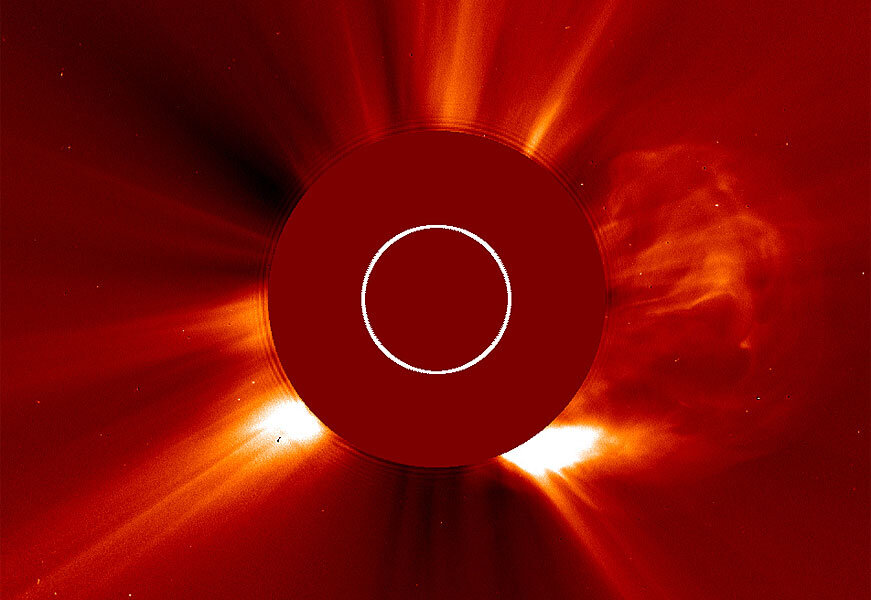How a massive solar storm almost wreaked havoc on Earth – but didn't
Loading...
This week marked the second anniversary of the most powerful solar storm earthlings have ever recorded – an enormous eruption of billions of tons of roiling hot gas that hurtled from the sun at some 5.6 million miles an hour.
For scientists, it represented an unprecedented opportunity to study an extreme example of a class of solar outbursts known as coronal-mass ejections (CMEs). The plasma swept past STEREO-A, one of two NASA spacecraft working in tandem to study the sun's outbursts, allowing the craft to take the full measure of the storm even as it took the full brunt of it.
For the rest of us, however, the anniversary may have been more important. It presented an opportunity to thank the sun for being polite enough to turn away before releasing that mighty belch.
Had the outburst reached Earth full-on, it could have triggered widespread power failures and radio blackouts, wreaked havoc on satellites and satellite-based navigation systems, and sent large electrical currents through pipelines, especially at high latitudes.
Indeed, solar scientists have since proposed that the event be used as a worst-case scenario for satellite owners, electrical utilities, pipeline operators, and airlines, among others, as they try to find ways to reduce vulnerability to stormy space weather.
The CME the sun launched on July 23, 2012, "wasn't an extreme event from a societal point of view" because "it didn't even come close to impacting the Earth," says Pete Riley, a space physicist with Predictive Science Inc. in San Diego. The company focuses on solar research. "But had that hit the earth, the consequences would have been huge."
For extreme solar storms, researchers use a powerful storm in 1859 as a benchmark. Dubbed the Carrington Event for the British astronomer Richard Carrington, who observed the flares on the sun that triggered a CME, it spurred aurora that could be seen as far south as Cuba, while people in the northeastern United States could read by it. The interaction between the CME and Earth's magnetic field triggered a geomagnetic storm that induced strong electrical currents in telegraph lines, causing many telegraph networks to fail and delivering shocks to telegraphers.
If a similar CME were to strike today, the US National Research Council has estimated that it would inflict some $2.6 trillion in losses to the global economy.
"We would still be picking up the pieces" if Earth had taken the full force of the CME, according to Daniel Baker, a solar physicist at the University of Colorado at Boulder and a member of a research team that modeled the effects of a direct hit at Earth, in an interview with NASA science writer Tony Phillips.
Dr. Baker and colleagues have estimated that the July 2012 CME would have delivered a geomagnetic storm comparable to the Carrington Event had it erupted from the Earth-facing side of the sun and arrived with the correct orientation for maximum interaction between the plasma's magnetic field and Earth's magnetic field.
One factor that appeared to contribute to the intensity of the July 2012 CME was the action of a CME about four days earlier, in what amounted to a round of cosmic curling.
In research published earlier this year, a team led by the Chinese Academy of Sciences' Ying Liu reported that a CME that erupted on July 19, 2012, swept a path through the more-gentle solar wind, which is made up of charged particles that stream from the sun even when it's storm-free. Following a relatively clear path, the July 23 event met with far less drag than it otherwise would have as it traveled from the sun, allowing it to maintain its enormous speed.
In addition, the team reported, the July 23 CME actually was two CMEs that the sun released in rapid succession. The two began to interact close to the sun, before the plasma clouds could expand. The rapid travel time out to Earth's orbit also would have kept the duo from expanding much, compared with a single CME cloud. Thus instead of getting hit with a solar Nerf ball, Earth's magnetic field would have been hit with a Jon Lester fastball.
With the July 23 event serving, at least for now, as a de facto "worst case," the question arises: How often can we expect these?
If measured from the perspective of earthlings, these events are rare. But their consequences are high. A first-cut calculation that Dr. Riley published in 2010 suggested that Earth stands a 12 percent chance of getting hit by an extreme CME within 10 years, based on the limited historical record for events that affected Earth and the criteria one uses to identify a CME as "extreme."
The 2012 event, he cautions, didn't affect Earth, so it doesn't count.








